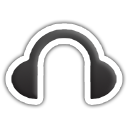4.8 KiB
The LinuxServer.io team brings you another container release featuring easy user mapping and community support. Find us for support at:
- forum.linuxserver.io
- IRC on freenode at
#linuxserver.io - Podcast covers everything to do with getting the most from your Linux Server plus a focus on all things Docker and containerisation!
linuxserver/headphones
headphones is an automated music downloader for NZB and Torrent, written in Python. It supports SABnzbd, NZBget, Transmission, µTorrent and Blackhole.
Usage
docker create \
--name="headphones" \
-v /path/to/headphones/data:/config \
-v /path/to/downloads:/downloads \
-v /path/to/music:/music \
-e PGID=<gid> -e PUID=<uid> \
-e TZ=<timezone> \
-p 8181:8181 \
linuxserver/headphones
Parameters
The parameters are split into two halves, separated by a colon, the left hand side representing the host and the right the container side. For example with a port -p external:internal - what this shows is the port mapping from internal to external of the container. So -p 8080:80 would expose port 80 from inside the container to be accessible from the host's IP on port 8080 http://192.168.x.x:8080 would show you what's running INSIDE the container on port 80.
-p 8181- the port(s)-v /config- Configuration file location-v /music- Location of music. (i.e. /opt/downloads/music or /var/music)-v /downloads- Location of downloads folder-e PGIDfor for GroupID - see below for explanation - optional-e PUIDfor for UserID - see below for explanation - optional-e TZfor setting timezone information, eg Europe/London
It is based on alpine linux with s6 overlay, for shell access whilst the container is running do docker exec -it headphones /bin/bash.
User / Group Identifiers
Sometimes when using data volumes (-v flags) permissions issues can arise between the host OS and the container. We avoid this issue by allowing you to specify the user PUID and group PGID. Ensure the data volume directory on the host is owned by the same user you specify and it will "just work" ™.
In this instance PUID=1001 and PGID=1001. To find yours use id user as below:
$ id <dockeruser>
uid=1001(dockeruser) gid=1001(dockergroup) groups=1001(dockergroup)
Setting up the application
Access WebUI at <your-ip>:8181 and walk through the wizard.
Info
-
To monitor the logs of the container in realtime
docker logs -f headphones. -
container version number
docker inspect -f '{{ index .Config.Labels "build_version" }}' headphones
- image version number
docker inspect -f '{{ index .Config.Labels "build_version" }}' linuxserver/headphones
Versions
- 16.01.19: Add pipeline logic and multi arch.
- 18.08.18: Rebase to alpine 3.8.
- 03.04.18: Remove forced port and update README.
- 05.01.18: Deprecate cpu_core routine lack of scaling.
- 12.12.17: Rebase to alpine 3.7.
- 20.07.17: Internal git pull instead of at runtime.
- 12.07.17: Add inspect commands to README, move to jenkins build and push.
- 28.05.17: Add flac package to handle FLAC based .cue.
- 25.05.17: Rebase to alpine 3.6.
- 03.05.17: Reduce layer, replace broken source for shntool.
- 07.02.17: Rebase to alpine 3.5.
- 23.12.16: Fix capitalisation in README.
- 09.09.16: Add layer badges to README.
- 27.08.16: Add badges to README, compile shntool.
- 08.08.16: Rebase to alpine linux.
- 18.07.15: Inital Release





